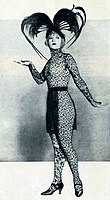A British comic is a periodical published in the United Kingdom that contains comic strips. It is generally referred to as a comic or a comic magazine, and historically as a comic paper.

Buster was a British comic which began publication in 1960, originally published by IPC Magazines Ltd under the company's comics division Fleetway, then by Egmont UK Ltd under the same imprint until its closure in 2000. Despite missing issues due to industrial action during its run, the comic published 1,902 issues in total. The comic carried a mixture of humour and adventure strips, featuring the title character Buster and a host of other characters.
Jackpot comic was a British comic book magazine that ran from the issues cover dated 5 May 1979 to issue 141, 30 January 1982, when it merged with Buster. The first issue cost 10p. The price increased to 12p from issue 63 (1980) and 14p from issue 98 in 1981

Monster Fun was originally a weekly British comic strip magazine for children aged seven to twelve. Published by IPC Media, it ran for 73 issues in 1975–1976, when it merged with Buster. Focused on humorous monster strips and stories, the magazine was known for "The Bad Time Bedtime Books" minicomic inserts, created by Leo Baxendale.
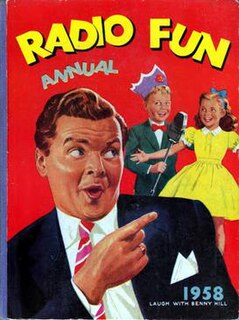
Radio Fun was a British celebrity comics comic paper that ran from 15 October 1938 to 18 February 1961, when it became the first out of twelve titles to merge with Buster.

Knockout may refer to one of two British comics. The original series, published by the Amalgamated Press, started on 4 March 1939 and ended on 16 February 1963, when it merged with Valiant. The second series, published by IPC Magazines, ran from 12 June 1971 to 23 June 1973, when it merged with Whizzer and Chips.

Buster Brown is a comic strip character created in 1902 by Richard F. Outcault. Adopted as the mascot of the Brown Shoe Company in 1904, Buster Brown, his sister Mary Jane, and his dog Tige, were well known to the American public in the early 20th century. The character's name was also used to describe a popular style of suit for young boys, the Buster Brown suit, that echoed his own outfit.
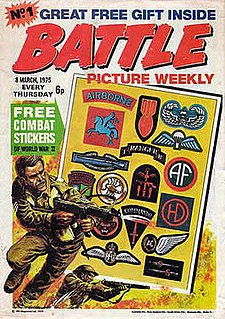
Battle Picture Weekly, at various times also known as Battle Action, Battle Action Force, Battle and Battle with Storm Force, was a British war comic book magazine published by IPC Magazines from 8 March 1975 to 23 January 1988, when it merged with the new incarnation of Eagle. Most stories were set in World War II, with some based on other conflicts.
The Amalgamated Press (AP) was a British newspaper and magazine publishing company founded by journalist and entrepreneur Alfred Harmsworth (1865–1922) in 1901, gathering his many publishing ventures together under one banner. At one point the largest publishing company in the world, AP employed writers such as Arthur Mee, John Alexander Hammerton, Edwy Searles Brooks, and Charles Hamilton; and its subsidiary, the Educational Book Company, published The Harmsworth Self-Educator, The Children's Encyclopædia, and Harmsworth's Universal Encyclopaedia. The company's newspapers included the Daily Mail, the Daily Mirror, The Evening News, The Observer, and The Times. At its height, AP published over 70 magazines and operated three large printing works and paper mills in South London.

TI Media was a consumer magazine and digital publisher in the United Kingdom, with a portfolio selling over 350 million copies each year. Most of its titles now belong to Future plc.
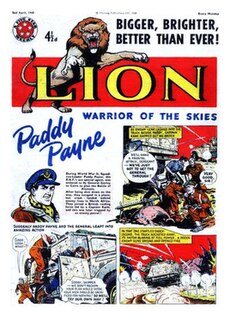
Lion was a weekly British comics periodical published by Amalgamated Press/Fleetway Publications from 23 February 1952 to 18 May 1974. A boys' adventure comic, Lion was originally designed to compete with Eagle, the popular weekly comic published by Hulton Press that had introduced Dan Dare. Lion lasted for 1,156 issues.
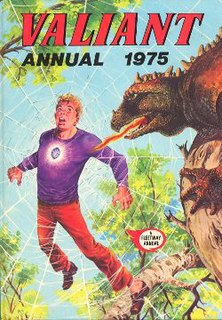
Valiant was a British boys' adventure comics anthology which ran from 1962 to 1976. It was published by IPC Magazines and was one of that company's major adventure titles throughout the 1960s and early 1970s.
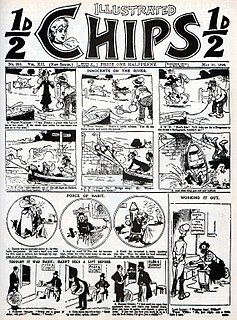
Illustrated Chips was a British comic magazine published between 26 July 1890 and 12 September 1953. Its publisher was the Amalgamated Press, run by Alfred Harmsworth. Priced at a half-penny, Illustrated Chips was among a number of Harmsworth publications that challenged the dominance in popularity of the "penny dreadfuls" among British children.
Funny Wonder was the name of a pre-War humorous comic published in the United Kingdom by Amalgamated Press. It was part of a long string of related titles which stretched from 1892 to 1953, known by a variety of additional titles, including Wonder, Jester, Jester and Wonder, Jolly Jester, Penny Wonder, and Halfpenny Wonder. There were two main (overlapping) runs, the first stretching from 1892 to 1940, and the second from 1912 to 1953; the first run being merged into the second. The most well-known, and longest-running single version, was Funny Wonder series 3, which ran 1,404 weekly issues from 1914 to 1942. Notable creators who worked on the comic include Reg Parlett and Roy Wilson.

Baba Yaga is a 1973 giallo film directed by Corrado Farina based on the Guido Crepax Valentina comic series. The film stars Carroll Baker, Isabelle De Funès and George Eastman. The subject is Valentina Rosselli, a Milanese photographer, who meets a middle-aged seductress who calls herself "Baba Yaga".
Celebrity comics are comics based on the fame and popularity of a celebrity. They are a byproduct of merchandising around a certain media star or franchise and have existed since the mass media and comics came into existence in the 19th century. Celebrity comics are usually not held in high esteem by critics, because of their purely commercial nature. They are solely created to capitalize on media trends and therefore published so quickly and cheaply that drawings and narratives tend to be of very low quality.
School Friend was the name of two different weekly publications marketed toward girls, both of which were pioneering in their respective categories. The first School Friend, published from 1919 to 1929, was the first story paper marketed exclusively to girls. The second School Friend, published from 1950 to 1965, is considered the first British girls' comic. Although both published by Amalgamated Press, and both marketed toward girls, the content of the two publications was not directly related.
Charlie Chaplin comics have been published in the United States, the United Kingdom, and Europe. Charlie Chaplin comic strips first appeared in 1915 in the U.S. and the U.K., cashing in on the tremendous popularity of the comedian at the time; they were some of the earliest comics inspired by the popularity of a celebrity. Although Charlie Chaplin comic strips didn't enjoy enduring popularity in the U.S., a Chaplin comic strip was published in the U.K. from 1915 until the late 1940s, while in France there were Chaplin comics published for more than 50 years.
Battler Britton is a British comics character created by Mike Butterworth and Geoff Campion. He first appeared in Amalgamated Press' Sun in 1956, and later was featured in Knockout, and the long-running digest titles Thriller Picture Library, Air Ace Picture Library, and War Picture Library.



